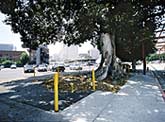
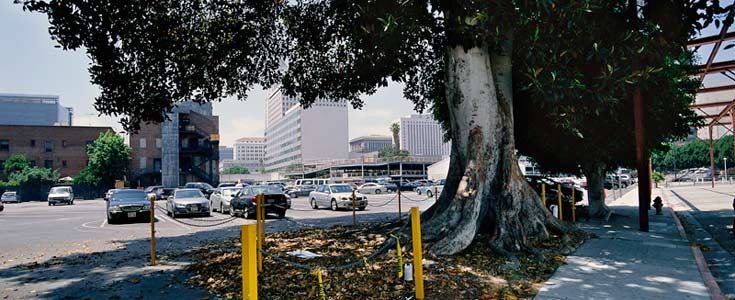
Photograph © Robert Glenn Ketchum
The Aoyama Tree is a 60- by 70-foot Moreton Bay Fig tree (Ficus macrophylla) located in the City of Los Angeles-owned parking lot immediately north of the National Center for the Preservation of Democracy, a component of the Japanese American National Museum. The tree marks the former location of the Koyasan Daishi Mission, one of the oldest and largest Buddhist temples in the city, and symbolizes the cultural and historical development of Buddhism and the Japanese American community. Despite benign neglect, the lack of an irrigation system, and the graffiti and asphalt covering portions of its extensive root system, the tree survives.
History
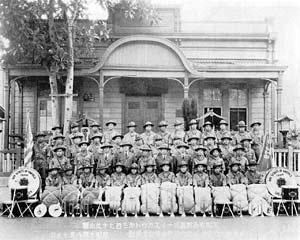
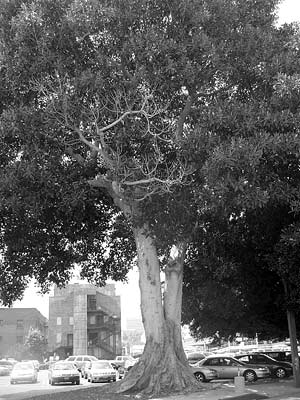
(top) Boy Scout Troop 379 seated in front of the Koyasan
Daishi Mission and fig tree in 1935; (bottom) The fig tree in 2008.
Courtesy Little Tokyo Historical Society
Reverend Shutai Aoyama came to the United States in 1909, taking jobs alongside other Japanese immigrants on farms and railroads and in shipyards. During this time, he became increasingly aware of the immigrant workers’ need for support and spiritual guidance. In 1912, he started the Koyasan Daishi Mission in a storefront on Commercial Street in Los Angeles’ Little Tokyo; later, he moved the temple to a wood-frame building at 133 North Central Avenue in 1920. The Moreton Bay Fig tree (Ficus macrophylla), now known as the Aoyama Tree, stood at the entrance of their new temple.
The temple continued to grow despite the economic hardships of the Great Depression, providing support to the community during an era of growing anti-Japanese rhetoric. In February 1935, President Franklin D. Roosevelt named the temple-supported Troop 379 an outstanding U. S. Boy Scout troop, and the Japanese/Japanese American troop traveled to Washington, D.C.
In 1937, the Koyasan Temple community purchased a lot on East First Street in Little Tokyo to build a new temple. Groundbreaking took place on November 17, 1939, and the temple opened the following year. The internment of all Japanese Americans on the west coast, following the December ’41 bombing of Pearl Harbor, put an end to the congregation’s meetings at the temple. However, the study, prayer, and even the Boy Scout activities that the congregation had established continued throughout the war at the War Relocation Authority camps.
The Koyasan Temple congregation had reconvened in Los Angeles by 1950, although the community had changed forever during the preceding decade. The Koyasan Temple community began to recover from the painful internment period with the establishment of the Sonenkai, or Young Buddhist Association, and, later, with the Harbor City Church and a Japanese language school. And Scout Troop 379 continues to be a vibrant part of Japanese American life in Little Tokyo. This persevering community looks forward to celebrating its centennial in 2012.
So what became of the Aoyama tree? The building that housed the former temple on Central Avenue had been razed by the City of Los Angeles to build a parking lot for the police department. Fortunately, throughout all of these changes and through several rounds of downtown redevelopment, the now-centenary Aoyama Tree was left undisturbed. At its historic location on North Central Avenue, it continues to reflect the rich legacy of Koyasan Temple, Buddhism, and Japanese American history in the United States. In March 2008, the 60 by 70 foot tree was designated Los Angeles Historic-Cultural Monument #920.
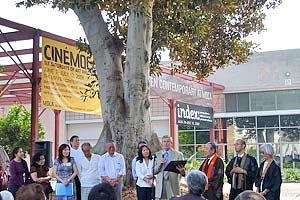
Aoyama Tree designation ceremony, July 17, 2008.
Photo by Fiona Potter, courtesy www.discovernikkei.org
Threat
The Aoyama Tree represents the early years of Koyasan Buddhist Temple, one of the oldest and largest Buddhist temples in Los Angeles; however, it has survived in a state of benign neglect for the past half-century. After the former temple building was razed, the tree was left without an irrigation system. The area immediately surrounding the tree was paved over, covering the tree's extensive roots system and further denying the tree essential water. Today, graffiti covers the exposed sections of root and lower portions of the tree’s trunk, further encouraging neglect.
